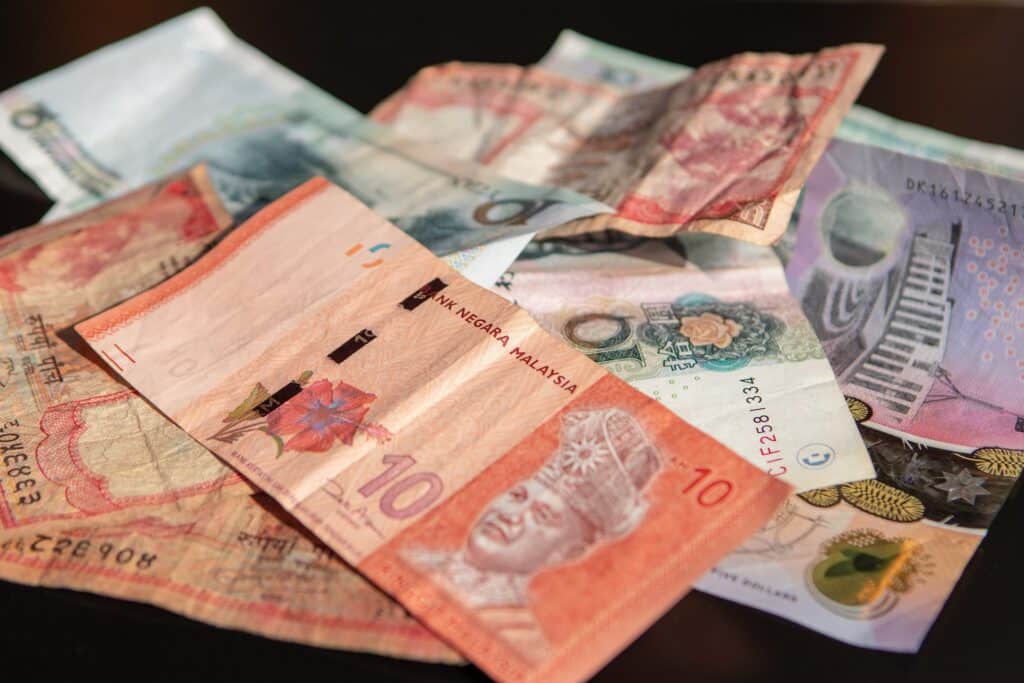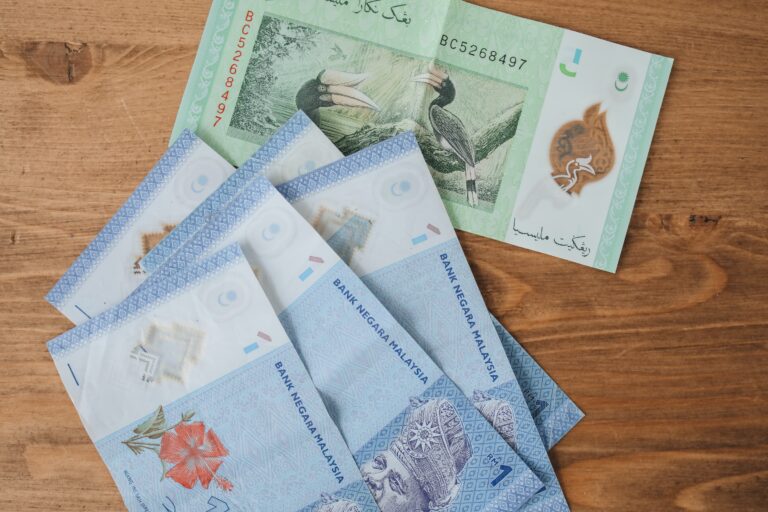The Malaysian Ringgit Malaysia (MYR) reflects the country’s industrial and tourism strength and is pegged closely to regional economic movements. The ringgit is the currency of Malaysia, the Southeast Asian nation known for its diverse peoples and landscapes as well as its thriving city centers. Although the Malaysian ringgit is sometimes used in border areas with other Asian countries, such as Indonesia and Thailand, it is not legal tender outside of Malaysia.
Whether you want to know more about the Malaysian ringgit for travel or because you send money to the country, this guide created by our team here at Remitly covers ringgit history, exchange rates, and essential facts.
What is the Malaysian ringgit?
As already stated, the ringgit is the main unit of Malaysian currency.
Ringgit means jagged in Malay. The name is a reference to the Castilian reales, Spanish coins that had jagged or serrated edges and were in circulation during the sixteenth and seventeenth centuries. However, ringgit as an adjective is now obsolete, so you don’t have to worry about confusion when you’re discussing the currency.
What is the currency code for the Malaysian ringgit?
A currency code is a three-character code used to identify currencies. The currency code for the ringgit is MYR.
To help you understand terminologies, here are some currency codes for other countries in the region:
- Brunei dollar: BND
- Hong Kong dollar: HKD
- Philippine peso: PHP
- Singapore dollar: SGD
- Vietnamese dong: VND
Are RM and MYR the same currency?
You may sometimes see the Malaysia currency referred to as RM rather than MYR. RM is just another abbreviation for the Malaysian ringgit. It means the same thing as MYR.
What is the Malaysian dollar?
The Malaysian dollar is just a nickname for the ringgit. If you hear the term, people are simply referring to Malaysian currency.
What is the currency symbol for the Malaysian ringgit?
Many countries have currency symbols. For example, the U.S., Australia, Canada, and other countries add a “$” to the front of an amount to show it’s in dollars, while the € denotes the Euro. Additionally, the Russian Ruble is another significant currency symbol used in international trade.
Malaysia’s currency doesn’t have a similar currency symbol.
How do you write Malaysian ringgit?
To write an amount in Malaysian ringgit, place the letters “RM” before the number with no space after the RM symbol. For example, you could write RM100 for 100 ringgit.
Malaysian Currency
In Malaysia, the central bank is Bank Negara Malaysia. Some people simply refer to it as the Central Bank of Malaysia. You may even see it called RM MYR Central Bank due to the currency symbols for the ringgit.
Bank Negara Malaysia is responsible for regulating Malaysia’s currency to ensure economic stability and keep the country at the forefront of emerging markets in the region. The central bank also orders the printing of official currency in the form of both banknotes and coins.
Read on to learn more about paper bills and cents in Malaysian currency.

Banknotes and coins of the Malaysian ringgit in use
The ringgit comes in the following denominations.
- RM1: These bills depict kite flying, a popular hobby in Malaysia.
- RM5: These bills show a Rhinoceros hornbill, a forest bird that plays an important role in traditional cultural ceremonies.
- RM10: These bills have an image of a Rafflesia flower on them. The species is the largest flower in the world and is native to Malaysia.
- RM20: These bills feature an image of sea turtles native to Malaysia, the leatherback, and the hawksbill.
- RM50: The phrase The National Mission: “To move the economy up the value chain” appears on these bills. It represents the country’s commitment to transforming its economy.
- RM100: These bills display images of two UNESCO World Heritage Sites located in Malaysia: Kinabalu Park in Sabah and Gunung Api Valley.
You might have noticed that the highest denomination of the ringgit is only 100. There used to be denominations of 500 and 1,000 in the 1990s. However, the Central Bank of Malaysia demonetized these higher denominations to help prevent money laundering.
Now, let’s take a look at cents in Malaysian currency. In the monetary system, the ringgit can be divided into 100 units called sen, so 100 sen make up one Malaysian ringgit. Sen coins come in the following denominations:
- 5 sen: These sens coins pay tribute to Destar Siga, a native form of fabric weaving.
- 10 sen: These sen coins feature imagery related to Orang Asli, the art of aboriginal tribes weaving leaves and plants into garments.
- 20 sen: The Bunga Melur or jasmine flower appears on these coins. This bloom has cultural significance for some ethnic groups in Malaysia and also serves as a material for traditional handicrafts.
- 50 sen: These coins bear images of pea tendrils called Sulur Kacang. Metalwork and jewelry produced in Malaysia often show off similar imagery.
The most current series of Malaysian ringgit and sen coins have “Distinctively Malaysia” as their theme. This theme embodies the culture and beauty of the country with depictions of famous scenery, wildlife, and traditions. You’ll also notice that all ringgits feature a portrait of Malaysia’s first prime minister, Tuanku Abdul Rahman.
The history of the ringgit and the Malaysian economy
The names of Malaysian banknotes and coins have changed over the years, both before and after Malaysia left Great Britain’s rule in August 1957.

Before Malaysian Independence
- 16th through 19th century — the Spanish-American silver dollar
- 19th century — the Straits dollar, Sarawak dollar, and the British North Borneo dollar
- 20th century — Malayan dollar and the Malaya and British Borneo dollar
After Malaysian Independence
- 1967 — the Malaysian dollar
- 1975 — the Malaysian ringgit
The Malaysian ringgit and sen have also featured commemorative designs for the following events throughout history:
- 1998 Commonwealth Games
- 100th Anniversary of the Malaysian Palm Oil Industry
- 60th Anniversary of the Signing of the Federation of Malaya Independence Agreement
Historical exchange rates
The historical exchange rates of the Malaysian ringgit (MYR) against major currencies, particularly the US dollar (USD), provide insight into the currency’s performance over time. The exchange rate varies based on economic conditions, market demand, and geopolitical events. From the introduction of the ringgit in June 1967 to present day, the USD rate has fluctuated significantly. A notable aspect is that in the year 2000, 1 MYR was valued at approximately 3.80 USD. The trend indicates a gradual depreciation of the ringgit, with the current exchange rate averaging around 4.57 MYR per USD as of 2024. Below is a table showing the historical exchange rates for the Malaysian ringgit against the US dollar over selected years:
null
| Year | MYR/USD Rate |
|---|---|
| 1970 | 3.06 |
| 1980 | 2.18 |
| 1990 | 2.70 |
| 1995 | 2.54 |
| 2000 | 3.80 |
| 2005 | 3.78 |
| 2010 | 3.06 |
| 2015 | 3.90 |
| 2020 | 4.20 |
| 2024 | 4.57 |
Asian financial crisis and US dollar currency peg (1997–2005)
The Asian financial crisis, which began in November 1997, significantly impacted the Malaysian ringgit and its exchange rate against the US dollar. During this period, the ringgit experienced a steep depreciation, plunging from around 2.50 MYR/USD to over 4.00 MYR/USD by early 1998. In response to this volatility, the Central Bank of Malaysia implemented a currency peg in September 1998, fixing the exchange rate at 3.80 MYR/USD to stabilize the economy. This measure aimed to curb capital flight and restore investor confidence. The peg lasted until July 2005, allowing the ringgit to gradually recover while remaining non-tradeable outside Malaysia.
Post-US dollar currency peg performance (2005–present)
After the end of the US dollar peg in 2005, the Malaysian ringgit entered a managed float system where its value was allowed to fluctuate based on market conditions. This shift saw the ringgit appreciate initially, reaching a high of approximately 3.16 MYR/USD in 2008. However, various domestic and international factors, including political uncertainties and global economic shifts, led to further fluctuations. For instance, by 2015, the currency had weakened again, trading at over 4.40 MYR/USD due to falling oil prices and increased political instability. As of 2024, the MYR is showing signs of recovery, indicating resilience against the US dollar, with the current average rate around 4.57 MYR/USD, reflecting a strengthening domestic economy.
The Malaysian economy today
Malaysia’s economy is the 38th largest in the world, and the fourth largest in Southeast Asia, according to the IMF. It’s a relatively affluent nation with a growing economy based on exports like electronics, petroleum products, and palm oil, and an affordable cost of living.
Because of their country’s strong economy, Malaysian citizens are less likely to immigrate abroad than others in the region. The greatest part of the Malaysian diaspora lives in neighboring Singapore, with significant numbers of people also settling in Australia.
What is the exchange rate for U.S. Dollars to Malaysian ringgit?
The Malaysian ringgit is considered a free-floating currency. This means that it has a floating or fluctuating rate, which the foreign exchange market determines.
The rate is dependent on the supply and demand of goods. This is the opposite of a fixed rate, which the government usually determines.
Because the ringgit is free-floating, its value rises and falls due to economic conditions in the country. When the ringgit’s value is low, prices in Malaysia may go up because the currency buys less.
Since Malaysia’s economy is stable, the value of the Malaysian ringgit doesn’t usually increase or decrease in value dramatically in the currency trading market. However, prices do fluctuate slightly.
Understanding exchange rates can be very important, especially if you’re looking to send money abroad. You can find Malaysia’s current exchange rates according to the Central Bank of Malaysia.

US dollar to Malaysian ringgit
The value of Malaysian currency compared to U.S. dollars or USD changes throughout the day. If you want to send money to Malaysia, exchange dollars for ringgits, or purchase ringgit shares, it’s important to check the exchange rate at any given time.
How much is $1 US in Malaysia?
As of April 25, 2023, one U.S. dollar was worth around 4.4465 ringgit.
How much is $500 US dollars in Malaysia?
The value of $500 USD in ringgit was 2218.75 as of April 25, 2023.
Expected Exchange Fees
When working with two currencies, you can expect to pay exchange fees, along with potential extra costs. How much you might pay to convert Malaysian ringgits to a new currency like U.S. dollars or Japanese yen varies. The same is true when you go from another currency to Malaysia’s currency.
To control costs when exchanging currency or sending money, compare exchange fees from more than one service whenever possible.
Paying by credit or debit card in Malaysia
Many stores and restaurants in Malaysia accept credit cards and debit cards from the Visa and Mastercard networks, especially in Kuala Lumpur. However, not all businesses do, so it’s a good idea to carry ringgit notes with you.
Malaysian businesses may charge transaction fees when you use a credit card for payment. In addition, your credit card company or bank may assess a fee for using your card in a foreign country on top of any exchange fees that apply.
Before traveling to Malaysia, call your credit card company or bank and let them know of your plans. Otherwise, the financial institution may decline the transaction because it gets flagged as potential fraud.
Whenever you’re traveling, it’s a good idea to photocopy the front and back of all the credit and debit cards that you carry. Keep the information in a safe place like your hotel room safe in case your wallet or bag gets lost or stolen.
Send money to Malaysia
If you’re looking to send money to Malaysia from Singapore, Australia, or several other countries, money transfer apps like Remitly make it easy. You’ll have the option of sending it to various banks or cash pickup locations around the country.
Once you determine how much you want to send, who you want to send it to, how they will receive it, and how quickly you want it to get there, you’re all set to transfer funds.
Convert MYR to USD at the real exchange rate
Converting Malaysian ringgit (MYR) to US dollars (USD) at the real exchange rate is crucial for individuals and businesses engaging in international transactions. The real exchange rate reflects the actual value of MYR against USD, free from markup or hidden fees often imposed by banks and money transfer services. As of the latest data from Xe, 1 MYR equals approximately 0.2356 USD, offering a transparent view of its value. To facilitate accurate conversions and avoid unfavorable rates, it’s recommended to use reliable online currency converters or financial services that provide real-time exchange rates, ensuring you get the best value for your money.
FAQs about the Malaysian Ringgit
What is the exchange rate for MYR against USD?
As of the latest data, the rate is approximately 4.4465 MYR to 1 USD.
Are there higher denominations than RM100?
No, denominations higher than RM100 were demonetized to combat money laundering.
Is MYR used outside Malaysia?
No, MYR is not legal tender outside Malaysia, though it is sometimes used in border areas.
What coins are available in Malaysian currency?
Coins are available in denominations of 5, 10, 20, and 50 sen.
Can I use credit cards in Malaysia?
Yes, especially in larger cities, but it’s wise to carry cash for smaller businesses.

